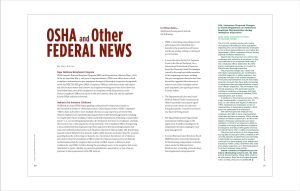OSHA and Other Federal News
New National Emphasis Program
OSHA issued a National Emphasis Program (NEP) on fall protection, effective May 1, 2023. In the 90 days after May 1, and prior to implementation, OSHA area offices were to draft compliance information to give employers during or following an inspection being made under the NEP. The NEP gives OSHA Compliance Officers authority to enter and inspect
any site/location where they observe any employee working more than 6 feet above the level below them, even if the employee is in compliance with fall protection rules.
Once a Compliance Officer has access to the site, however, they may cite the employer
for any OSHA violations observed.
Instance by Instance Citations
On March 27, 2023, OSHA began applying a new policy for inspections, known as
the “Instance by Instance” citation procedure. Under this procedure, OSHA Compliance
Officers have authority to issue multiple citations on any inspection site where they observe employers are repeatedly exposing workers to life-threatening hazards or failing to comply with certain workplace safety and health requirements. Following a catastrophic injury—i.e., one involving hospitalization for treatment of at least one employee, a fatality, the loss of an eye, or the amputation of any extremity—if a Compliance Officer is inspecting a site and they find that employees have been exposed to life-threatening hazards, they may issue individual citations for each employee exposed to the hazard(s). Life-threatening hazards include fall protection hazards, ladder safety hazards, excavation hazards, machine guarding hazards, lockout tag-out hazards, etc. An instance-by-instance set of citations also may be issued if a Compliance Officer observes employees exposed to such hazards and determines that the employer had received a willful, repeat, or failure to abate
violation for any OSHA violation during the preceding 5 years; or the employer had at any time failed to report a fatality, in-patient hospitalization, amputation, or loss of an eye
pursuant to the requirements of 29 CFR 1904.39.
In Other News…
Additional developments include the following.
- OSHA is examining expanding current enforcement of combustible dust hazards to the manufacture of trusses and the secondary cutting or sawing of precut lumber.
- A recent decision by the U.S. Supreme Court in the Glacier Northwest, Inc. v. International Brotherhood of Teamsters found the Teamsters liable for damages caused to the employer while members of the bargaining unit were striking. The pro-management decision has been decried by organized labor because it removes one of the strategies used to push employers into agreeing to terms to settle strikes.
- The Department of Labor has joined with the Federal Trade Commission in efforts to prohibit noncompete agreements or such clauses in contracts/ hiring documents. Counsel is not aware of a final rule being issued.
- The Equal Employment Opportunity Commission held hearings on the application of artificial intelligence in employment decision-making by company management.
- A recent National Labor Relations Board (NLRB) decision revises the framework for determining independent contractor status under the National Labor Relations Act, overruling a 2019 decision that emphasized entrepreneurial opportunity as a key factor when evaluating a worker’s independence to pursue economic gain. The NLRB returned to a traditional, common-law test that requires consideration of several factors, not placing greater weight on any one factor. The independent business analysis considers whether the worker has a significant entrepreneurial opportunity, has a realistic ability to work for other companies, has proprietary or ownership interest in their work, and has control over important business decisions such as the scheduling of the contractor’s performance; hiring, selection, and assignment of employees; purchase and use of equipment; and commitment of capital.
NIA provides the information in this article as an educational resource to promote a safer industry. While the information provided is based on the NIA’s and the author’s best judgment and the best information available at the time the article was prepared, NIA encourages all readers to consult with their safety experts and legal counsel for their unique business circumstances or when making changes to their safety programs.
DOL Announces Proposed Changes to Clarify Regulations on Authorized Employee Representation during Workplace Inspections
Seeks public, stakeholder comments on proposed changes

